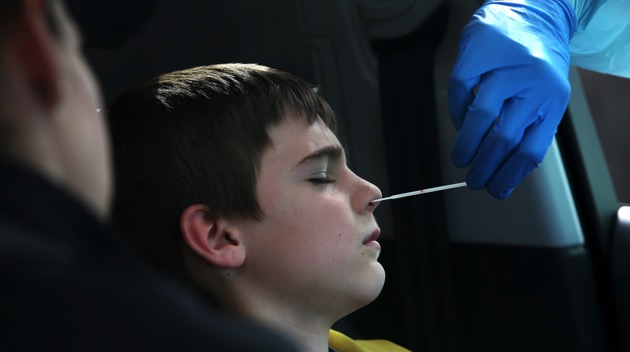Inside Oklahoma’s surge of COVID-19 cases and hospitalizations among children
Lisa Maree Williams/Getty Images
(OKLAHOMA CITY) — Oklahoma doctors say they are seeing a massive surge of COVID-19 cases and hospitalizations among children — more than during any previous wave of the pandemic.
Between Jan. 9 and Jan. 15, more than 16,000 children under the age of 18 tested positive for COVID-19, making up 18.7% of all cases in the state that week, according to a weekly epidemiology and surveillance report from the Oklahoma State Department of Health.
That’s a 138% increase from the 6,700 children who contracted the virus the week before and a 566% spike from the 2,400 children who tested positive for the virus the week before Thanksgiving.
“If l look back just to two months ago — kind of October, November — that number tended to be between five and 10,” Dr. Cameron Mantor, acting chief medical officer at OU Health, told ABC News. “In the past three weeks now, we’ve just seen it continue to skyrocket.”
At Oklahoma Children’s Hospital OU Health, more than 50 pediatric patients are currently hospitalized with COVID-19 for the first time ever — a tenfold increase from just two months ago and three times as high as last winter’s surge.
Kids of all ages have been admitted, from as young as 2 weeks old up through teenagers, according to Mantor.
He said it’s not clear whether more children have been hospitalized because the omicron variant — which is fueling the recent wave — causes more severe illness or because the number of children being infected is so high that, naturally, the hospitalization rate will rise too.
Compared to adults, though, children with COVID-19 at Oklahoma Children’s Hospital have required intensive care treatment at lower rates, he said.
About 10% of children who have been admitted to intensive care units need oxygen support or mechanical ventilation compared to 25% of adults at OU Health.
However, even though most children recover from COVID-19, this doesn’t mean they don’t suffer complications.
Mantor said more kids have been diagnosed with multisystem inflammatory syndrome in children, or MIS-C, during this wave than in previous waves.
MIS-C is a condition in which different body parts can become inflamed, such as the heart, lungs and kidneys, and is often seen in children after they are diagnosed with COVID, according to the Centers for Disease Control and Prevention.
Additionally, during an OU Health roundtable discussion held on Wednesday afternoon, Dr. Stephanie DeLeon, inpatient medical director at Oklahoma Children’s Hospital OU Health, said the hospital has recently seen children diagnosed with COVID encephalitis, meaning these patients have inflammation in their brains and have symptoms including altered mental states and seizures.
Health officials have stressed the importance of vaccinating children.
The weekly report from the OSDH shows that as of Jan. 8 — the latest date for which data is available — there were 32 children aged 17 and younger hospitalized statewide over the last 30 days.
Of those children, 31 were unvaccinated, including 17 children aged 5 and older who are eligible to receive vaccines.
Just one fully vaccinated child was hospitalized and no partially vaccinated children were admitted to hospitals.
“When we look at the state of Oklahoma, around 60% have had at least one vaccine dose, but the kids 5 and older who can get vaccinated, that percentage is still very small,” Mantor said.
Only 33.6% of Oklahoma children between ages 12 and 17 are fully vaccinated, according to the OSDH report. For kids aged 5 to 11, just 9% are fully vaccinated.
COVID-19 vaccines for children under age 5 have not yet been authorized by the U.S. Food and Drug Administration.
“It’s the same old message that we’ve been preaching for two years now that to try to prevent the transmission of the disease, both amongst our pediatric patients but also from our pediatric patients to mom and dad and to grandma and grandad, is we have to get vaccinated,” Mantor said.”The kids that haven’t been vaccinated have to get vaccinated. It’s safe, it’s effective, it works.”
He added, “It’s not perfect. People are still getting infected with the virus but their likelihood of requiring hospitalization or becoming severely ill is much, much less if you’re fully vaccinated, so vaccines are so important. We need to really continue to push that in our aged 5 and older patients.”
Copyright © 2022, ABC Audio. All rights reserved.

